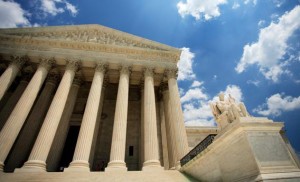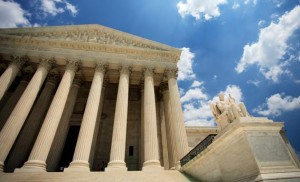 One of the relentless memes that keeps cropping up in the marriage equality battle is that, were the Supreme Court to grant full broad based and constitutionally protected marriage equality in the Hollingsworth v. Perry Prop 8 case, there would be a destructive backlash consuming the country on the issue.
One of the relentless memes that keeps cropping up in the marriage equality battle is that, were the Supreme Court to grant full broad based and constitutionally protected marriage equality in the Hollingsworth v. Perry Prop 8 case, there would be a destructive backlash consuming the country on the issue.
A good example of the argument was propounded by Professor Eric Segall at the ACSBlog in a piece entitled “Same-Sex Marriage, Political Backlash and the Case for Going Slow”:
There may be a better way. The Court could strike down DOMA under heightened scrutiny making it clear that government classifications based on sexual orientation receive heightened scrutiny. The Court could dismiss the Proposition 8 case on standing grounds (there are substantial standing arguments which the Court asked the parties to brief). This combination would leave all state laws (except perhaps California’s) intact but subject to likely successful challenges. Obviously, this would be a slower and more expensive route to marriage equality, but it might make the right more secure over time while decreasing the chances of serious backlash.
I know that it is easy for a straight male like me to suggest that the Court should refrain from quickly and forcefully resolving the same sex marriage issue on a national basis. But issues that some gays care deeply about are not limited to marriage equality, just like feminists face many challenges other than abortion such as equal pay, equality in the military, and glass ceiling barriers. Where gender equality would be without Roe is unknowable but even Justice Ruth Bader Ginsburg has observed that the right to choose today might be more secure if the Court hadn’t decided it “in one fell swoop.” I don’t know what will happen if the Court announces a national rule on same-sex marriage but history strongly suggests that a more incremental approach might better serve the long term interests of people who identify themselves as liberals and progressives, including gays and lesbians.
I like and respect Eric quite a lot, but I cannot agree with him, nor other advocates of this position (for further discussion of the “Roe backlash” theory, see Adam Liptak in the New York Times). I have long strongly advocated for a full, broad based, ruling for equality for all, in all states, most recently here. But the issue of “backlash” has not previously been specifically addressed in said discussions that I recall.
Fortunately, there are already superb voices who have addressed this issue. The first is from Harvard Law Professor Michael Klarman in the LA Times:
What sort of political backlash might such a decision ignite?
…
Constitutionalizing gay marriage would have no analogous impact on the lives of opponents. Expanding marriage to include same-sex couples may alter the institution’s meaning for religious conservatives who believe that God created marriage to propagate the species. But that effect is abstract and
long-term. The immediate effect of a marriage equality ruling would be that the gay couple already living down the street would become eligible for a marriage license — and nothing would change in the daily lives of gay-marriage opponents. That is why strong initial support for a state constitutional amendment to overturn the Massachusetts court ruling rapidly dissipated once same-sex couples began to marry.
…
Thus, while a broad marriage equality ruling would undoubtedly generate some backlash, its scope would be far less than that ignited by Brown or Roe. A majority of Americans would immediately endorse such a decision, and support would increase every year. Opposition would be far less intense than it was to school desegregation or abortion because the effect of same-sex marriage on others’ lives is so indirect. Some politicians would roundly condemn the ruling, though many Republicans and most Democrats would not. State officials would have no way to circumvent such a decision, nor would many same-sex couples be intimidated out of asserting their right to marry. Outright defiance is conceivable, though it seems unlikely that any state governor would be willing to go to jail for contempt of court.The likeliest scenario, in the event of a pro-equality ruling, is immediate, strident criticism from some quarters, followed by same-sex couples marrying in states where they previously could not. Very little will change in the day-to-day lives of opponents, and the issue will quickly fade in significance.
Klarman’s article goes through pretty much every facet of the “backlash” theory, and knocks them all down in order. It is an excellent read, and I suggest you do so as there is much more there.
And Professor Scott Lemieux writing at his blog Lawyers, Guns & Money, opines:
The specific, oft-cited argument made by Ginsburg is, I think, wrong in two crucial respects. First of all, Ginsburg’s argument that the decision would have been more broadly accepted had it rested on equal protection grounds is almost certainly wrong. The public evaluates decisions based on results, not reasoning, and essentially nobody without a professional obligation to do so reads Supreme Court opinions. Second, I don’t understand the argument that a “minimalist” opinion just striking down the Texas law wouldn’t have generated a backlash. The Texas law, while extreme in terms of its language and implications, wasn’t “extreme” in the sense of being an outlier; more than 30 states substantively identical abortion statutes that also would have been struck down. And following that, of course, would have been additional rounds of litigation to determine whether arbitrary panels of doctors and other “reform” laws were constitutional. That’s not a formula for lesser conflict.
In terms of application to the same-sex marriage cases, then, liberals shouldn’t be hoping to win by losing or whatever. There’s no reason to believe that a broad opinion invalidating same-sex marriage would produce any more backlash than legislative repeals would. There would be more “backlash” only if you (plausibly) assume that absent Supreme Court decisions many states would maintain their bans on same-sex marriage for a long time. In other words, you can avoid backlash by just not winning, an argument I consider self-refuting.
For a much longer explication on the false premise of the “Roe backlash” phenomenon, see Lemieux’s law review length article “Roe and the Politics of Backlash: Countermobilization Against the Courts and Abortion Rights Claiming” which opens up with a discussion of the backlash created by a case directly analogous to the Prop 8 situation, Lawrence v. Texas. Suffice it to say that, as Scott notes, there was some early collateral backlash, but there was not anything like predicted and, almost exactly a decade later, it seems like a distant memory that hardly happened.
This is important, because Lawrence v. Texas was a broad sweeping decision invalidating a single state’s (Texas) anti-sodomy law, but giving a full mandate that settled the issue once and for all, for all citizens nationwide. Despite many commenters having opined before the decision that the Lawrence court must rule narrowly and “go slow”. Sound familiar? It should. Same goes mostly for the Loving decision on interracial marriage. There was some grousing, but then people moved on.
Marriage equality is more popular, and trending ever more so at nearly light speed, than interracial marriage and invalidation of anti-sodomy laws were at the time of Loving and Lawrence respectively. Even the conservatives are figuring out that many of their sons, daughters, sisters, brothers and friends are gay. Not all may personally accept gay marriage, but the air is out of the hate against it. Even Chief Justice John Roberts’ niece is out and gay. And she will be sitting in the Roberts family section today at the oral argument on Hollingsworth v. Perry/Prop 8.
As one of Scott Lemieux’s commenters, “Just Dropping By” succinctly, and quite correctly, noted:
To put it another way, opposing same-sex marriage once such marriages start happening makes you look like a monster who wants to break up other people’s marriages. Opposing abortion makes you look like someone who wants to save cute babies from being killed. People don’t like imagining themselves as monsters; they do like imagining themselves as heroes. This is why millions of hours, and billions of dollars, have been spent fighting Roe v. Wade, while there’s no major national group devoted to overturning Loving v. Virginia.
Exactly right. That is the case against the “backlash”. The fear is overstated, and the time is now for equality for all, in all the states. For the Supreme Court to do less would be nothing less than a direct sanction for continued regional and state based bigotry and discrimination. That is not American, it is not constitutional, and it is no longer tolerable.




